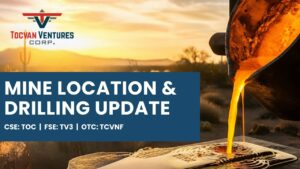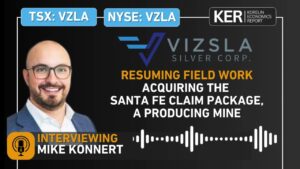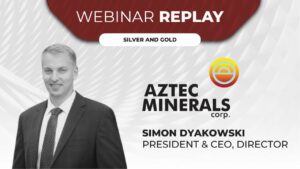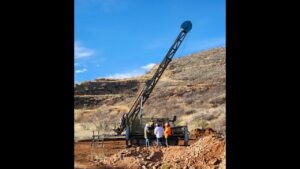HALIFAX, NOVA SCOTIA – September 7, 2017 – Oceanus Resources Corporation (TSXV:OCN and OTCQB:OCNSF) (“Oceanus” or the “Corporation”) reports it has received assay results of channel samples collected from the legacy underground exploration tunnels on the unmined Protectora, Caleigh and Fundadora veins located north of the old El Tigre Mine (see Figure 1 Location Map).
In the Fundadora workings, the most significant result is from Channel ETLU-254 which returned 19.5 g/t gold equivalent consisting of 14.7 g/t gold and 359.8 g/t silver across a true width of 5.20 meters; including57.3 g/t gold equivalent consisting of 43.5 g/t gold and 1,039.5 g/t silver across a true width of 1.70 meters.
In the Caleigh workings, channel sample ETLU-242 returned 48.2 g/t gold equivalent consisting of 25.5 g/t gold and 1,704.2 g/t silver over a true width of 0.50 meters. Channel ETLU-243 returned 34.8 g/t gold equivalent consisting of 12.6 g/t gold and 1,659.4 g/t silver over a true width of 1.0 meters.
In the Protectora workings, channel sample ETLU-215 returned 5.70 g/t gold equivalent consisting of 1.59 g/t gold and 308.3 g/t silver across a true width of 1.25 meters; and channel sample ETLU-218 returned 3.94 g/t gold equivalent consisting of 2.09 g/t gold and 112.7 g/t silver across a true width of 1.50 meters.
Glenn Jessome, President and CEO of Oceanus reports, “The high-grade gold-silver-base metal mineralization in the Protectora, Caleigh and Fundadora Veins is an exciting new development on the El Tigre property. The results from the mapping and sampling of the underground workings present a series of high priority drill targets for this fall over a 2 kilometer strike length north of the old El Tigre Mine.”
As press released on June 7, 2017 and June 27, 2017, drill hole ET-17-144 in the Protectora Vein returned 0.85 meters of 135.1 g/t gold equivalent consisting of 37.2 g/t gold, 7,338.9 g/t silver as well as 2.84% copper, 1.38% lead and 4.06% zinc. The gold equivalent ratio is based on a gold to silver price ratio of 1:75 (Au:Ag) and does not include the copper, lead and zinc values. Drill hole ET-17-144 was the last drill hole of the 62 hole drill program completed in May, 2017. Drill hole 144 was a step-out hole located approximately 800 meters to the north of the old El Tigre Mine. The mineralized zone consists of several vuggy quartz veins and veinlets carrying galena, sphalerite, chalcopyrite, stromeyerite and pyrite within a strongly silicified and kaolinized alteration zone.
Underground Channel Sample Program
Oceanus mapped and sampled the historical workings north of the El Tigre mine during the summer exploration program. The goals of the program were to map and identify the styles of mineralization and alterations exposed in the old workings and to collect a suite of channel samples to document the gold, silver and base metal grades. This work combined with field mapping would facilitate selecting drill targets for the fall 2017 drilling program. A total of 990 channel samples have been collected to date.
Channel samples were collected from nine underground exploration tunnels over a 2.0 kilometer strike length of the Protectora vein between Section 5650 and Section 7600 North and from additional exploration tunnels on the Fundadora and Caleigh Vein. None of these veins have been mined. The first exploration tunnel on the Protectora Vein is located 650m north along strike from the northern end of the old El Tigre Mine workings
After surveying the tunnels, the geologists mapped the quartz veins and then collected channel samples across the back (roof) of the tunnels. The majority of the mine openings are between 1.0 to 2.0 meters wide and so the channel widths are limited to this approximate length. The geologists collected samples of the hanging wall alteration zone, the quartz vein material and the footwall alteration zones and the reported result is the weighted average grade across the width of the mine opening. The high grade silver values are related to the quartz vein material. The quartz veins and alteration zones exposed in these exploration workings are similar to those found in the historical El Tigre Mine workings.
The average grade of the samples in a tunnel is provided. The significant channel sample assay results are set out in the table below (see Figure 1 Sample Location Map).
Vein | Channel | Comment | From | To | Length | Au | Ag | EqAu751 |
|
|
| (m) | (m) | (m) | (g/t) | (g/t) | (g/t) |
Protectora | ETLU-215 | 0.00 | 1.25 | 1.25 | 1.59 | 308.3 | 5.70 | |
Protectora | ETLU-216 | 0.00 | 1.70 | 1.70 | 1.34 | 243.1 | 4.58 | |
Protectora | ETLU-218 | 0.00 | 1.50 | 1.50 | 2.09 | 112.7 | 3.94 | |
Protectora | ETLU-220 | 0.60 | 1.10 | 0.50 | 5.19 | 11.7 | 5.35 | |
Protectora | ETLU-225 | 0.00 | 1.20 | 1.20 | 3.35 | 293.9 | 7.27 | |
including | 0.70 | 1.20 | 0.50 | 7.74 | 701.6 | 17.09 | ||
Protectora | ETLU-247 | 0.00 | 1.00 | 1.00 | 3.69 | 660.8 | 12.50 | |
including | 0.50 | 1.00 | 0.50 | 7.35 | 1,221.1 | 23.63 | ||
Caleigh | ETLU-242 | 0.00 | 0.50 | 0.50 | 25.46 | 1,704.2 | 48.18 | |
Caleigh | ETLU-243 | 0.00 | 1.00 | 1.00 | 12.65 | 1,659.4 | 34.77 | |
Fundadora | ETLU-067 | 0.70 | 1.75 | 1.05 | 12.89 | 869.9 | 24.49 | |
Fundadora | ETLU-253 | 0.00 | 3.30 | 3.30 | 2.77 | 124.1 | 4.42 | |
including | 2.30 | 3.30 | 1.00 | 7.80 | 200.0 | 10.46 | ||
Fundadora | ETLU-254 | 0.00 | 5.20 | 5.20 | 14.66 | 359.8 | 19.45 | |
including | 3.50 | 5.20 | 1.70 | 43.48 | 1,039.5 | 57.34 | ||
Fundadora | ETLU-255 | 0.00 | 4.40 | 4.40 | 3.72 | 163.2 | 5.89 | |
including | 0.90 | 1.90 | 1.00 | 3.82 | 473.6 | 10.13 | ||
including | 3.90 | 4.40 | 0.50 | 18.21 | 247.7 | 21.51 | ||
Fundadora | ETLU-262 | 0.50 | 1.50 | 1.00 | 4.87 | 1,244.6 | 21.46 | |
Fundadora | ETLU-342 | 0.00 | 0.50 | 0.50 | 3.89 | 537.2 | 11.06 | |
Fundadora | ETLU-343 | 0.00 | 0.50 | 0.50 | 2.58 | 899.8 | 14.58 | |
Fundadora | ETLU-348 | 0.50 | 1.00 | 0.50 | 3.31 | 823.1 | 14.28 |
Note: 1. Gold Equivalent (“EqAu75”) ratio based on gold to silver price ratio of 1:75 (Au:Ag)
El Tigre Resource Estimate
As previously announced Oceanus has completed the 2016-17 infill drilling program at El Tigre with a total of 62 diamond drill holes totalling 11,923.1 meters. The purpose of this drill program was to support a NI 43-101 resource estimation for the El Tigre Property (“Resource Estimate”). The results from the Oceanus drilling, prior drilling and other data will be incorporated into the Resource Estimate being completed by P&E Mining Consultants Inc. (“P&E”). The results of drill hole 144, with its high-grade gold, silver and base metals mineralization, required P&E to conduct another site visit to El Tigre, and in particular the Protectora Vein, prior to the Corporation releasing its Resource Estimate. The required P&E site visit was conducted in July, 2017. As a result of the new discoveries at the Protectora Vein Oceanus now expects the Resource Estimate will be completed and released in the first half of September, 2017.
El Tigre Property
The El Tigre Property lies at the northern end of the Sierra Madre gold belt which hosts many epithermal gold and silver deposits including Ocampo, Pinos Altos, Dolores and Palmarejo. In 1896, gold was first discovered on the property in the Gold Hill area and mining started with the Brown Shaft in 1903. The focus soon changed to mining high-grade silver veins in the area with the majority of the production coming from the El Tigre vein. Underground mining on the El Tigre vein extended 1,450 meters along strike and mined on 14 levels to a depth of 450 meters. By the time the mine closed in 1938, it is reported to have produced a total of 353,000 ounces of gold and 67.4 million ounces of silver from 1.87 million tons (Craig, 2012).
The El Tigre Property is approximately 35 kilometers long and comprises 21,842.78 hectares. The El Tigre gold and silver deposit is related to a series of high-grade epithermal veins controlled by a north-south trending structure cutting across the andesitic and rhyolitic tuffs of the Sierra Madre Volcanic Complex within a broad gold and silver mineralized prophylitic alternation zone. The veins dip steeply to the west and are typically 1 meter wide but locally can be up to 5 meters in width. The veins, structures and mineralized zones outcrop on surface and have been traced for a distance of 5.3 kilometers along strike. Historical mining and exploration activities focused on a 1.5 kilometer portion of the southern end of the deposits, principally on the El Tigre, Seitz Kelly and Sooy veins. Four veins in the north (Aguila, Escondida, Fundadora and Protectora) were explored with only limited amounts of production.
Lab Preparation and Assay
The sealed and tagged sample bags are transported to the ActLabs facility in Zacatecas, Mexico. ActLabs crushes the samples and prepares 200-300 gram pulp samples with ninety percent passing Tyler 150 mesh (106μm). The pulps are assayed for gold using a 50 gram charge by fire assay (Code 1A2-50) and over limits greater than 10 grams per tonne are re-assayed using a gravimetric finish (Code 1A3-50).
Silver and multi-element analysis is completed using 4 acid total digestion (Code 1F2 Total Digestion ICP). Over limits greater than 100 grams per tonne silver are re-assayed using a gravimetric finish (Code 8-Ag FA-GRAV Ag). Over limits greater than 10,000 ppm for copper, lead and zinc are re-assayed using 4 acid total digestion (Code 8-4A AAS) and reported in percent.
Quality Assurance / Quality Control and Data Verification
Quality assurance and quality control (“QA/QC”) procedures monitor the chain-of-custody of the samples and includes the systematic insertion and monitoring of appropriate reference materials (certified standards, blanks and duplicates) into the sample strings. The results of the assaying of the QA/QC material included in each batch are tracked to ensure the integrity of the assay data. All results stated in this announcement have passed Oceanus’ QA/QC protocols.
Qualified Person
David R. Duncan, P. Geo., V.P. Exploration of the Corporation, is the Qualified Person for Oceanus as defined under National Instrument 43-101. Mr. Duncan has reviewed and approved the scientific and technical information in this press release and has reviewed the Technical Report.
About Oceanus Resources Corporation
Oceanus Resources Corporation is a gold exploration company operating in Mexico. Oceanus is managed by a team of mine finders with extensive experience in exploring and developing large hydrothermal gold projects in Mexico. Oceanus is currently exploring the El Tigre Property in the Sierra Madre Occidental.
For further information, please contact:
Glenn Jessome
President and CEO
902 492 0298
jessome@oceanusresources.ca
CAUTIONARY STATEMENT:
Neither TSX Venture Exchange nor its Regulation Services Provider (as that term is defined in the policies of the TSX Venture Exchange) accepts responsibility for the adequacy or accuracy of this release.
This News Release includes certain “forward-looking statements”. All statements other than statements of historical fact included in this release, including, without limitation, statements regarding potential mineralization, resources and reserves, the ability to convert inferred resources to indicated resources, the ability to complete future drilling programs and infill sampling, the ability to extend resource blocks, the similarity of mineralization at El Tigre to the Ocampo mine, exploration results, and future plans and objectives of Oceanus, are forward-looking statements that involve various risks and uncertainties. Forward-looking statements are frequently characterized by words such as “may”, “is expected to”, “anticipates”, “estimates”, “intends”, “plans”, “projection”, “could”, “vision”, “goals”, “objective” and “outlook” and other similar words. Although Oceanus believes the expectations expressed in such forward-looking statements are based on reasonable assumptions, there can be no assurance that such statements will prove to be accurate and actual results and future events could differ materially from those anticipated in such statements. Important factors that could cause actual results to differ materially from Oceanus’s expectations include risks and uncertainties related to exploration, development, operations, commodity prices and global financial volatility, risk and uncertainties of operating in a foreign jurisdiction as well as additional risks described from time to time in the filings made by Oceanus with securities regulators.
Figure 1 Underground Exploration Tunnel Location Map


















